西安旅游景点英文介绍 (带图片)
- 格式:docx
- 大小:1.88 MB
- 文档页数:6
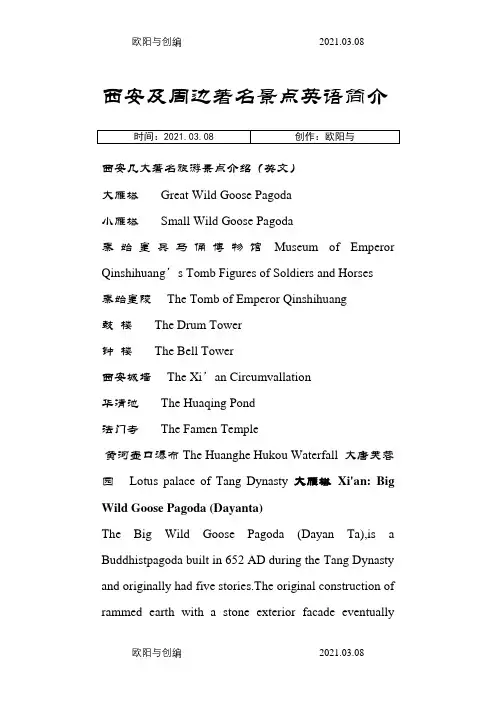
西安及周边著名景点英语简介西安几大著名旅游景点介绍(英文)大雁塔 Great Wild Goose Pagoda小雁塔 Small Wild Goose Pagoda秦始皇兵马俑博物馆Museum of Emperor Qinshihuang’s Tomb Figures of Soldiers and Horses秦始皇陵 The Tomb of Emperor Qinshihuang鼓楼 The Drum Tower钟楼 The Bell Tower西安城墙 The Xi’an Circumvallation华清池 The Huaqing Pond法门寺 The Famen Temple黄河壶口瀑布 The Huanghe Hukou Waterfall 大唐芙蓉园Lotus palace of Tang Dynasty 大雁塔Xi'an: Big Wild Goose Pagoda (Dayanta)The Big Wild Goose Pagoda (Dayan Ta),is a Buddhistpagoda built in 652 AD during the Tang Dynasty and originally had five stories.The original construction of rammed earth with a stone exterior facade eventuallycollapsed five decades later but was rebuilt by Empress Wu Zetian in 704AD who added five more stories. A massive earthquake in 1556 heavily damaged the pagoda and reduced it by three stories to its current height of seven stories One of the pagoda's many functions was to hold sutras and figurines of the Buddha that were brought to China from Indiaby Xuanzang, a famous Chinese Buddhist monk, scholar, traveler, and translator.Xuanzang is a prominent Buddhist figure mostly known for his seventeen year overland trip to India and back, which is recorded in detail in his autobiography and a biography, and which provided the inspiration for the epic novel “Journey to the West”. The pagoda is built on the premises of the Temple of Great Maternal Grace (Da Ci'en), originally built in 589 AD and then rebuilt 647 AD by the Tang Emperor Gaozong in memory of his mother EmpressWende. Before the gates of the temple stands a statue of Xuanzang.大雁塔北广场North Square of Big Wild Goose PagodaSurrounding Big Wild Goose Pagoda, the scenery is alsoquite charming, especially the square north of the Da Ci'en Temple. Covering about 110,000 square meters (131563 square yards) plus 20,000 square meters (23920.6 square yards) of water area, it holds many records: in Asia, it is the biggest Tang-culture square, the biggest fountain and waterscape square, and the largest-scale sculptures area. In the world, it has the most benches, the longest light-belt, and the largest-scale acoustic complex. The entire square is composed of waterscape fountains, a cultural square, gardens and tourist paths. There you can taste real Chinese culture and traditions and fully enjoy the truly attractive views. With reliefs on the theme of the prosperous Tang Dynasty, 200-meter-long (656-foot-long) sculpture groups, 8 groups of sculpted figures, 40 relievos on the land, and 22 styles of musical fountains, it has become a must-see when you visit Big Wild Goose秦始皇兵马俑The Museum of Qin Terra-cotta Warriors and HorsesOne of the most significant archaeological finds in the world, this 16,300-square-meter excavation reveals morethan 7,000 life-size terracotta figures of warriors and horses arranged in battle formations. (3 pits) The terracotta warriors and horses, created about 2,200 years ago, were found in 1974 on the east side of the tomb of the First Emperor Qin Shihuang (259 BC - 210 BC) near Xi'an. Emperor Qin Shihuang had Ying as his surname and Zheng as his given name. In 221 B.C., when he unified the whole country, named himself Shihuang Di and carried on the hereditary system. To protect against harassment by the Hun aristocrats. Emperor Qin Shihuang ordered the Great Wall be built.钟楼The Bell Tower (Zhonglou)Centrally located on the "Four Main Roads" junction is the BellTower, of Xi'an. The original CityBellTower was constructed in 1582 and situated in the west, but on its reconstruction in 1739, the tower was relocated to its present site. A Ming dynasty bell weighing approximately 14.76 tons hangs in the tower, but no longer chimes to inform residents of the time of day. Visitors have the chance to inspect up-close a number of smaller bells. Although the site itself is more of a landmark than anattraction, it is frequently enlivened with local performances. Visitors interested in local music should visit the site in the morning and early afternoon. Originally, the tower had a number of entrances, but today, it only has one accessible entrance located on Bei Dajie close to the Admission Ticket Office.鼓楼Xi'an: DrumTower (Gulou)The DrumTower was built in 1380 during the early Ming Dynasty, and got its name from the hugedrum located within the building. In contrast to the BellTower ,where bell was stricken at dawn, drum was beat at sunset to indicate the end ofthe day. There are twenty-four drums in the northand south sides of the DrumTower . These drums standfor the Twenty-four Solar Terms, a form of weather calendar created by theChinese in order to guide the agricultural production.西安城墙The Xi’an CircumvallationThe Xi’an Circumvallation site is located at the cent er of xi’an city with the form of a rectangular. The circumvallation, with its wall height of 12 meters, bottom width of 18 meters and top width of 15 meters, consists of4 city gates: changle gate to the east, anding gate to the west, yongling gate to the south and anyuan gate to the north. Its east wall has the length of 2590 meters, west wall of 2631.2 meters, south wall of 3441.6 meters and north wall of 3241 meters. It was constructed on the basis of the tang imperial city and under the strategic consideration of defense. The thickness of the wall is larger than its height and is very solid that cars can run on it. The existing circumvallation was built during 1373-1378 with the history of more than 600 years. It is one of the most famous wall constru ction in China’s history after the middle ages as well as the most preserved ancient one in China.小雁塔Small Wild Goose PagodaThe Small Wild Goose Pagoda, sometimes Little Wild Goose Pagoda (Chinese: 小雁塔; pinyin: Xiǎoyàn Tǎ), is one of two significant pagodas in the city of Xi'an, China, the site of the old Han and Tang capital Chang'an. The other notable pagoda is the Giant Wild Goose Pagoda, originally built in 652 and restored in 704. The Small Wild Goose Pagoda was built between 707–709, duringthe Tang Dynasty under Emperor Zhongzong of Tang (r 705–710). The pagoda stood 45 m (147 ft) until the 1556 Shaanxi earthquake. The earthquake shook the pagoda and damaged it so that it now stands at a height of 43 m (141 ft) with fifteen levels of tiers.[1] The pagoda has a brick frame built around a hollow interior, and its square base and shape reflect the building style of other pagodas from the era.[1] During the Tang Dynasty, the Small Wild Goose Pagoda stood across a street from its mother temple, the Dajianfu Temple. Pilgrims brought sacred Buddhist writings to the temple and pagoda from India, as the temple was one of the main centers in Chang'an for translating Buddhist texts.[1] The temple was older than the pagoda, since it was founded in 684, exactly 100 days after the death of Emperor Gaozong of Tang (r. 649–683).[1] Emperor Zhongzong had donated his residence to the building of a new temple here, maintaining the temple for 200 monks in honor of his deceased father Gaozong.[1] The temple was originally called the Daxianfusi or Great Monastery of Offered Blessings by Zhongzong, until it was renamed Dajianfusi by Empress Wu Zetian in 690.华清池Huaqing Hot SpringsHuaqing Hot Springs, also known as HuaqingPalace, is a well-known historic site and an AAAAA tourist attraction of China. It gets its fame for being the place where the romantic story of Emperor Tangxuanzong of Tang Dynasty (618-907) and his beloved Yang Guifei (or Concubine Yang) took place. As a matter of fact, the site had been as an imperial palace for emperors' short stays away from the capital for more than 3000 years. Emperors of Zhou, Qin, Han, Sui and Tang dynasties spent the winter at this place every year. Emperor Zhouyouwang of Western Zhou Dynasty (1046BC-771BC) is said to be the first emperor who ordered to build a palace at the site. In the following dynasties, the palace was repaired and expanded for several times, given the name of "Hot Spring Palace" and finally denominated "HuaqqingPalace" by Emperor Tangxuanzong. The palace was constructed above hot springs, hence the site is also called "Huaqing Hot Springs".法门寺The Famen TempleFamenTemple, renowned for storing the veritable FingerBone of the Sakyamuni Buddha, is located in Fufeng County of Shaanxi Province. FamenTemple was established in the Eastern Han Dynasty (25--220) for spreading Buddhism. The most representative structures in the temple are the Famen Temple Pagoda and FamenTempleMuseum. Many royal treasures and jewelry were found here. But why? FamenTemple was the royal temple during the Sui Dynasty (581-618) and Tang Dynasty. Emperors in Sui and Tang believed that enshrining and worshiping the bone of Sakyamuni would bring richness and peace to the land and its people. So an offering of treasure to the finger bone was made, which was housed in the UndergroundPalace.壶口瀑布Hukou WaterfallThe Hukou waterfall on the Huanghe River west of Jixian County, Shanxi, is formed when the river flows to the Hukou Mountains on the Shanxi-Shaanxi border and its 250-meter-wide bed, sandwiched between the canyons on its banks, abruptly narrows into a trough 50 meters wide and 30 meters deep and falls down into a big stone-strewn pool. The section of the river here is like the mouth of awater-flash. Hence the name of the waterfall, which means “ Flask Mouth waterfall”. The waterfall has a descent of 15-20 meters in the low-water season, but it is scarcely noticeable as a waterfall in the high –water season when the waters burst into rapid torrents. The section is rich in hydroelectric power potential陕西历史博物馆Xi'an: ShanxiHistoryMuseumOne thing surprising at the ShaanxiProvincialHistoryMuseum was the fact that it is possible, even expected, to bargain for the items sold at the gift shops. One would assume that a museum would have fixed prices. It turns out that ithe prices provide are only the starting price. You should bargain for everything you buy at the gift shop. You can expect to save at least 50%, possibly more.大唐芙蓉园Lotus palace of Tang Dynasty (Tang Paradise)Tang Par adise lies in the Qujiang New District, Xi’An City, ShannxiProvince, with 66.7 hectares building areas and 20 hectares of lake areas inside. The garden is the biggest culture theme part in Northwest China, with 1.3欧阳与创编 2021.03.08billion RMB investments. The Tang Paradise, which was rebuilt at the north of archaeological site of Lotus Palace of Tang Dynasty, is the first large scale royal garden culture theme garden which fully exhibits the living styles and features of Glorious age of Tang Dynasty. In this project, we c reated a unique night view of “Splendid and magnificent, Glorious age of Tang Dynasty”, by fully controlling the combination of “Lighting” and “Shadow”欧阳与创编 2021.03.08。
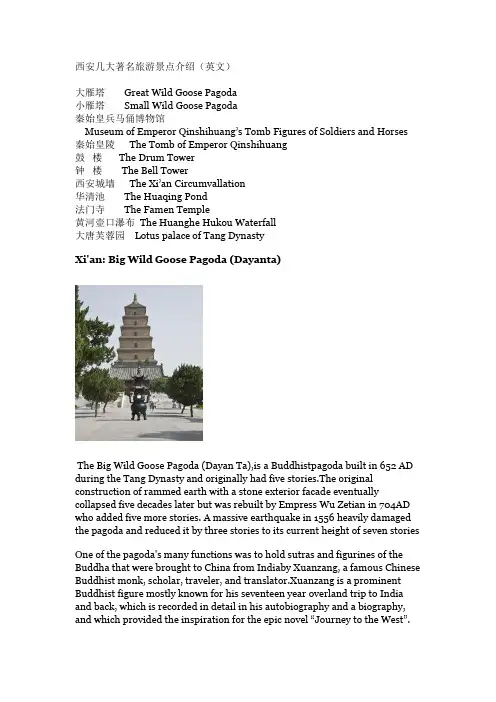
西安几大著名旅游景点介绍(英文)大雁塔Great Wild Goose Pagoda小雁塔Small Wild Goose Pagoda秦始皇兵马俑博物馆Museum of Emperor Qinshihuang’s Tomb Figures of Soldiers and Horses秦始皇陵The Tomb of Emperor Qinshihuang鼓楼 The Drum Tower钟楼The Bell Tower西安城墙The Xi’an Circumvallation华清池The Huaqing Pond法门寺The Famen Temple黄河壶口瀑布The Huanghe Hukou Waterfall大唐芙蓉园Lotus palace of Tang DynastyXi'an: Big Wild Goose Pagoda (Dayanta)The Big Wild Goose Pagoda (Dayan Ta),is a Buddhistpagoda built in 652 AD during the Tang Dynasty and originally had five stories.The original construction of rammed earth with a stone exterior facade eventually collapsed five decades later but was rebuilt by Empress Wu Zetian in 704AD who added five more stories. A massive earthquake in 1556 heavily damaged the pagoda and reduced it by three stories to its current height of seven stories One of the pagoda's many functions was to hold sutras and figurines of the Buddha that were brought to China from Indiaby Xuanzang, a famous Chinese Buddhist monk, scholar, traveler, and translator.Xuanzang is a prominent Buddhist figure mostly known for his seventeen year overland trip to India and back, which is recorded in detail in his autobiography and a biography, and which provided the inspiration for the epic novel “Journey to the West”.The pagoda is built on the premises of the Temple of Great Maternal Grace (Da Ci'en), originally built in 589 AD and then rebuilt 647 AD by the Tang Emperor Gaozong in memory of his mother EmpressWende.Before the gates of the temple stands a statue of Xuanzang.North Square of Big Wild Goose PagodaSurrounding Big Wild Goose Pagoda, the scenery is also quite charming, especially the square north of the Da Ci'en Temple. Covering about 110,000 square meters (131563 square yards) plus 20,000 square meters (23920.6 square yards) of water area, it holds many records: in Asia, it is the biggest Tang-culture square, the biggest fountain and waterscape square, and the largest-scale sculptures area. In the world, it has the most benches, the longest light-belt, and the largest-scale acoustic complex.The entire square is composed of waterscape fountains, a cultural square, gardens and tourist paths. There you can taste real Chinese culture and traditions and fully enjoy the truly attractive views. With reliefs on the theme of the prosperous Tang Dynasty, 200-meter-long (656-foot-long) sculpture groups, 8 groups of sculpted figures, 40 relievos on the land, and 22 styles of musical fountains, it has become a must-see when you visit Big Wild Goose The Museum of Qin Terra-cotta Warriors and HorsesOne of the most significant archaeological finds in the world, this16,300-square-meter excavation reveals more than 7,000 life-size terracotta figures of warriors and horses arranged in battle formations. (3 pits)The terracotta warriors and horses, created about 2,200 years ago, were found in 1974 on the east side of the tomb of the First Emperor Qin Shihuang (259 BC - 210 BC) near Xi'an.Emperor Qin Shihuang had Ying as his surname and Zheng as his given name. In 221 B.C., when he unified the whole country, named himself Shihuang Di and carried on the hereditary system.To protect against harassment by the Hun aristocrats. Emperor Qin Shihuang ordered the Great Wall be built.The Bell Tower (Zhonglou)Centrally located on the "Four Main Roads" junction is the Bell Tower, of Xi'an. The original City Bell Tower was constructed in 1582 and situated in the west, but on its reconstruction in 1739, the tower was relocated to its present site. A Ming dynasty bell weighing approximately 14.76 tons hangs in the tower, but no longer chimes to inform residents of the time of day. Visitors have the chance to inspect up-close a number of smaller bells.Although the site itself is more of a landmark than an attraction, it is frequently enlivened with local performances. Visitors interested in local music should visit the site in the morning and early afternoon.Originally, the tower had a number of entrances, but today, it only has one accessible entrance located on Bei Dajie close to the Admission Ticket Office.Xi'an: Drum Tower (Gulou)The Drum Tower was built in 1380 during the early Ming Dynasty, and got its name from the hugedrum located within the building. In contrast to the Bell Tower ,where bell was stricken at dawn, drum was beat at sunset to indicate the end ofthe day.There are twenty-four drums in the northand south sides of the Drum Tower . These drums standfor the Twenty-four Solar Terms, a form of weather calendar created by theChinese in order to guide the agricultural production. The Xi’an CircumvallationThe Xi’an Circumvallation site is located at the center of xi’an c ity with the form of a rectangular. The circumvallation, with its wall height of 12 meters, bottom width of 18 meters and top width of 15 meters, consists of 4 city gates: changle gate to the east, anding gate to the west, yongling gate to the south and anyuan gate to the north. Its east wall has the length of 2590 meters, west wall of 2631.2 meters, south wall of 3441.6 meters and north wall of 3241 meters. It was constructed on the basis of the tang imperial city and under the strategic consideration of defense. The thickness of the wall is larger than its height and is very solid that cars can run on it. The existing circumvallation was built during1373-1378 with the history of more than 600 years. It is one of the mostfamous wall construction in China’s history after the middle ages as well as the most preserved ancient one in China.Small Wild Goose PagodaThe Small Wild Goose Pagoda, sometimes Little Wild Goose Pagoda (Chinese: 小雁塔; pinyin: Xiǎoyàn Tǎ), is one of two significant pagodas in the city ofXi'an, China, the site of the old Han and Tang capital Chang'an. The other notable pagoda is the Giant Wild Goose Pagoda, originally built in 652 and restored in 704. The Small Wild Goose Pagoda was built between 707–709, during the Tang Dynasty under Emperor Zhongzong of Tang (r 705–710). The pagoda stood 45 m (147 ft) until the 1556 Shaanxi earthquake. The earthquake shook the pagoda and damaged it so that it now stands at a height of 43 m (141 ft) with fifteen levels of tiers.[1] The pagoda has a brick frame built around a hollow interior, and its square base and shape reflect the building style of other pagodas from the era.[1]During the Tang Dynasty, the Small Wild Goose Pagoda stood across a street from its mother temple, the Dajianfu Temple. Pilgrims brought sacred Buddhist writings to the temple and pagoda from India, as the temple was one of the main centers in Chang'an for translating Buddhist texts.[1] The temple was older than the pagoda, since it was founded in 684, exactly 100 days after the death of Emperor Gaozong of Tang (r. 649–683).[1] Emperor Zhongzong had donated his residence to the building of a new temple here, maintaining the temple for 200 monks in honor of his deceased father Gaozong.[1] The temple was originally called the Daxianfusi or Great Monastery of Offered Blessings by Zhongzong, until it was renamed Dajianfusi by Empress Wu Zetian in 690.Huaqing Hot SpringsHuaqing Hot Springs, also known as Huaqing Palace, is a well-known historic site and an AAAAA tourist attraction of China. It gets its fame for being the place where the romantic story of Emperor Tangxuanzong of Tang Dynasty (618-907) and his beloved Yang Guifei (or Concubine Yang) took place.As a matter of fact, the site had been as an imperial palace for emperors' short stays away from the capital for more than 3000 years. Emperors of Zhou, Qin, Han, Sui and Tang dynasties spent the winter at this place every year. Emperor Zhouyouwang of Western Zhou Dynasty (1046BC-771BC) is said to be the first emperor who ordered to build a palace at the site. In the following dynasties, the palace was repaired and expanded for several times, given the name of "Hot Spring Palace" and finally denominated "Huaqqing Palace" by Emperor Tangxuanzong. The palace was constructed above hot springs, hence the site is also called "Huaqing Hot Springs".The Famen TempleFamen Temple, renowned for storing the veritable Finger Bone of the Sakyamuni Buddha, is located in Fufeng County of Shaanxi Province.Famen Temple was established in the Eastern Han Dynasty (25--220) for spreading Buddhism. The most representative structures in the temple are the Famen Temple Pagoda and Famen Temple Museum.Many royal treasures and jewelry were found here. But why? Famen Temple was the royal temple during the Sui Dynasty (581-618) and Tang Dynasty. Emperors in Sui and Tang believed that enshrining and worshiping the bone of Sakyamuni would bring richness and peace to the land and its people. So an offering of treasure to the finger bone was made, which was housed in the Underground Palace.Hukou WaterfallThe Hukou waterfall on the Huanghe River west of Jixian County, Shanxi, is formed when the river flows to the Hukou Mountains on the Shanxi-Shaanxi border and its 250-meter-wide bed, sandwiched between the canyons on its banks, abruptly narrows into a trough 50 meters wide and 30 meters deep and falls down into a big stone-strewn pool. The section of the river here is like the mouth of a water-flash. Hence the name of the waterfall, which means “ Flask Mouth waterfall”. The waterfall has a descent of 15-20 meters in the low-water season, but it is scarcely noticeable as a waterfall in the high –water season when the waters burst into rapid torrents. The section is rich in hydroelectric power potentialXi'an: Shanxi History MuseumOne thing surprising at the Shaanxi Provincial History Museum was the fact that it is possible, even expected, to bargain for the items sold at the gift shops. One would assume that a museum would have fixed prices. It turns out that ithe prices provide are only the starting price. You should bargain for everything you buy at the gift shop. You can expect to save at least 50%, possibly more.Lotus palace of Tang Dynasty (Tang Paradise)Tang Paradise lies in the Qujiang New District, Xi’An City, Shannxi Province, with 66.7 hectares building areas and 20 hectares of lake areas inside. The garden is the biggest culture theme part in Northwest China, with 1.3 billion RMB investments. The Tang Paradise, which was rebuilt at the north of archaeological site of Lotus Palace of Tang Dynasty, is the first large scale royal garden culture theme garden which fully exhibits the living styles and features of Glorious age of Tang Dynasty.In this project, we created a unique night view of “Splendid and magnificent, Glorious age of Tang Dynasty”, by fully controlling the combi nation of “Lighting” and “Shadow”。

西安著名景点英文简介 Company number:【WTUT-WT88Y-W8BBGB-BWYTT-19998】西安及周边着名景点英语简介西安几大着名旅游景点介绍(英文)大雁塔 Great Wild Goose Pagoda小雁塔 Small Wild Goose Pagoda秦始皇兵马俑博物馆 Museum of Emperor Qinshihuang’s Tomb Figures of Soldiersand Horses秦始皇陵 The Tomb of Emperor Qinshihuang鼓楼 The Drum Tower钟楼 The Bell Tower西安城墙 The Xi’an Circumvallation华清池 The Huaqing Pond法门寺 The Famen Temple黄河壶口瀑布 The Huanghe Hukou Waterfall 大唐芙蓉园 Lotus palace of Tang Dynasty 大雁塔Xi'an: Big Wild Goose Pagoda (Dayanta)The Big Wild Goose Pagoda (Dayan Ta),is a Buddhistpagoda built in 652 AD during the Tang Dynasty and originally had five original construction of rammed earth with a stone exterior facade eventually collapsed five decades later but was rebuilt by Empress Wu Zetian in 704AD who added five more stories. A massive earthquake in 1556 heavily damaged the pagoda and reduced it by three stories to its current height of seven stories One of the pagoda's many functions was to hold sutras and figurines of the Buddha that were brought to China from Indiaby Xuanzang, a famous Chinese Buddhist monk, scholar, traveler, and is a prominent Buddhist figure mostly known for his seventeen year overland trip to India and back, which is recorded in detail in his autobiography and a biography, and which provided the inspiration for the epic novel “Journey to the West”. The pagoda is built on the premises of the Temple ofGreat Maternal Grace (Da Ci'en), originally built in 589 AD and then rebuilt 647 AD by the Tang Emperor Gaozong in memory of his mother EmpressWende. Before the gates of the temple stands a statue of Xuanzang.大雁塔北广场North Square of Big Wild Goose PagodaSurrounding Big Wild Goose Pagoda, the scenery is also quite charming, especially the square north of the Da Ci'en Temple. Covering about 110,000 square meters (131563 square yards) plus 20,000 square meters square yards) of water area, it holds many records: in Asia, it is the biggest Tang-culture square, the biggest fountain and waterscape square, and the largest-scale sculptures area. In the world, it has the most benches, the longest light-belt, and the largest-scale acoustic complex. The entire square is composed of waterscape fountains, a cultural square, gardens and tourist paths. There you can taste real Chinese culture and traditions and fully enjoy the truly attractive views. With reliefs on the theme of the prosperous Tang Dynasty, 200-meter-long (656-foot-long) sculpture groups, 8 groups of sculpted figures, 40 relievos on the land, and 22 styles of musical fountains, it has become a must-see when you visit Big Wild Goose秦始皇兵马俑The Museum of Qin Terra-cotta Warriors and HorsesOne of the most significant archaeological finds in the world, this 16,300-square-meter excavation reveals more than 7,000 life-size terracotta figures of warriors and horses arranged in battle formations. (3 pits) The terracotta warriors and horses, created about 2,200 years ago, were found in 1974 on the east side of the tomb of the First Emperor Qin Shihuang (259 BC - 210 BC) near Xi'an. Emperor Qin Shihuang had Ying as his surname and Zheng as his given name. In 221 ., when he unified the whole country, named himself Shihuang Di and carried on the hereditary system. To protect against harassment by the Hun aristocrats. Emperor Qin Shihuang ordered the Great Wall be built.钟楼The Bell Tower (Zhonglou)Centrally located on the "Four Main Roads" junction is the Bell Tower, of Xi'an. The original City Bell Tower was constructed in 1582 and situated in the west, but on its reconstruction in 1739, the tower was relocated to its present site. A Ming dynasty bell weighing approximately tons hangs in the tower, but no longer chimes to inform residents of the time of day. Visitors have the chance to inspect up-close a number of smaller bells. Although the site itself is more of a landmark than an attraction, it is frequently enlivened with local performances. Visitors interested in local music should visit the site in the morning and early afternoon. Originally, the tower had a number of entrances, but today, it only has one accessible entrance located on Bei Dajie close to the Admission Ticket Office.鼓楼Xi'an: Drum Tower (Gulou)The Drum Tower was built in 1380 during the early Ming Dynasty, and got its name from the hugedrum located within the building. In contrast to the Bell Tower ,where bell was stricken at dawn, drum was beat at sunset to indicate the end ofthe day. There are twenty-four drums in the northand south sides of the Drum Tower . These drums standfor the Twenty-four Solar Terms, a form of weather calendar created by theChinese in order to guide the agricultural production.西安城墙The Xi’an CircumvallationThe Xi’an Circumvallation site is located at the center of xi’an city with the form of a rectangular. The circumvallation, with its wall height of 12 meters, bottom width of 18 meters and top width of 15 meters, consists of 4 city gates: changle gate to the east, anding gate to the west, yongling gate to the south and anyuan gate to the north. Its east wall has the length of 2590 meters, west wall of meters, south wall of meters and north wall of 3241 meters. It was constructed on the basis of the tang imperialcity and under the strategic consideration of defense. The thickness of the wall is larger than its height and is very solid that cars can run on it. The existing circumvallation was built during 1373-1378 with the history of more than 600 years. It is one of the most famous wall construction in China’s history after the middle ages as well as the most preserved ancient one in China.小雁塔Small Wild Goose PagodaThe Small Wild Goose Pagoda, sometimes Little Wild Goose Pagoda (Chinese: 小雁塔; pinyin: Xiǎoyàn Tǎ), is one of two significant pagodas in the city of Xi'an, China,the site of the old Han and Tang capital Chang'an. The other notable pagoda is the Giant Wild Goose Pagoda, originally built in 652 and restored in 704. The Small Wild Goose Pagoda was built between 707–709, during the Tang Dynasty under Emperor Zhongzong of Tang (r 705–710). The pagoda stood 45 m (147 ft) until the 1556 Shaanxi earthquake. The earthquake shook the pagoda and damaged it so that it now stands at a height of 43 m (141 ft) with fifteen levels of tiers.[1] The pagoda has a brick frame built around a hollow interior, and its square base and shape reflect the building style of other pagodas from the era.[1] During the Tang Dynasty, the Small Wild Goose Pagoda stood across a street from its mother temple, the Dajianfu Temple. Pilgrims brought sacred Buddhist writings to the temple and pagoda from India, as the temple was one of the main centers in Chang'an for translating Buddhist texts.[1] The temple was older than the pagoda, since it was founded in 684, exactly 100 days after the death of Emperor Gaozong of Tang (r. 649–683).[1] Emperor Zhongzong had donated his residence to the building of a new temple here, maintaining the temple for 200 monks in honor of his deceased father Gaozong.[1] The temple was originally called the Daxianfusi or Great Monastery of Offered Blessings by Zhongzong, until it was renamed Dajianfusi by Empress Wu Zetian in 690.华清池Huaqing Hot SpringsHuaqing Hot Springs, also known as Huaqing Palace, is a well-known historic site and an AAAAA tourist attraction of China. It gets its fame for being the place where the romantic story of Emperor Tangxuanzong of Tang Dynasty (618-907) and his beloved Yang Guifei (or Concubine Yang) took place. As a matter of fact, the site had been as an imperial palace for emperors' short stays away from the capital for more than 3000 years. Emperors of Zhou, Qin, Han, Sui and Tang dynasties spent the winter at this place every year. Emperor Zhouyouwang of Western Zhou Dynasty (1046BC-771BC) is said to be the first emperor who ordered to build a palace at thesite. In the following dynasties, the palace was repaired and expanded for several times, given the name of "Hot Spring Palace" and finally denominated "Huaqqing Palace" by Emperor Tangxuanzong. The palace was constructed above hot springs, hence the site is also called "Huaqing Hot Springs".法门寺The Famen TempleFamen Temple, renowned for storing the veritable Finger Bone of the Sakyamuni Buddha, is located in Fufeng County of Shaanxi Province. Famen Temple was established in the Eastern Han Dynasty (25--220) for spreading Buddhism. The most representative structures in the temple are the Famen Temple Pagoda and Famen Temple Museum. Many royal treasures and jewelry were found here. But why Famen Temple was the royal temple during the Sui Dynasty (581-618) and Tang Dynasty. Emperors in Sui and Tang believed that enshrining and worshiping the bone of Sakyamuni would bring richness and peace to the land and its people. So an offering of treasure to the finger bone was made, which was housed in the Underground Palace.壶口瀑布Hukou WaterfallThe Hukou waterfall on the Huanghe River west of Jixian County, Shanxi, is formed when the river flows to the Hukou Mountains on the Shanxi-Shaanxi border and its 250-meter-wide bed, sandwiched between the canyons on its banks, abruptly narrows into a trough 50 meters wide and 30 meters deep and falls down into a big stone-strewn pool. The section of the river here is like the mouth of a water-flash. Hence the name of the waterfall, which means “ Flask Mouth waterfall”. The waterfall has a descent of 15-20 meters in the low-water season, but it is scarcely noticeable as a waterfall in the high –water season when the waters burst into rapid torrents. The section is rich in hydroelectric power potential陕西历史博物馆Xi'an: Shanxi History MuseumOne thing surprising at the Shaanxi Provincial History Museum was the fact that it is possible, even expected, to bargain for the items sold at the gift shops. One would assume that a museum would have fixed prices. It turns out that ithe prices provide are only the starting price. You should bargain for everything you buy at the gift shop. You can expect to save at least 50%, possibly more.大唐芙蓉园Lotus palace of Tang Dynasty (Tang Paradise)Tang Paradise lies in the Qujiang New District, Xi’An City, Shannxi Province, with hectares building areas and 20 hectares of lake areas inside. The garden is the biggest culture theme part in Northwest China, with billion RMB investments. The Tang Paradise, which was rebuilt at the north of archaeological site of Lotus Palace of Tang Dynasty, is the first large scale royal garden culture theme garden which fully exhibits the living styles and features of Glorious age of Tang Dynasty. In this project, we created a unique night view of “Splendid and magnificent, Glorious age of Tang Dynasty”, by fully controlling the combination of “Lighting” and “Shadow”。
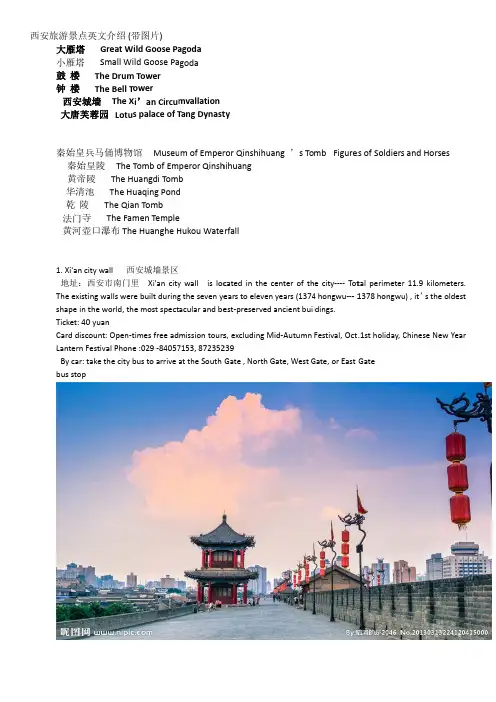
西安安旅游景点英大雁塔 小雁塔 鼓 楼 钟 楼 西安城大唐芙秦始皇兵 秦始皇 黄帝陵华清池乾 陵 法门寺黄河壶1. Xi'an ci 地址:西The existi shape in tTicket: 40Card disco Lantern F By car: t bus stop英文介绍 (带 Great Wi Small Wi The Drum The Bell To城墙 The X 蓉园 Lotus 兵马俑博物馆皇陵 The T 陵 The Hu 池 The Hu The Qia 寺 The Fam 壶口瀑布 The ty wall 西西安市南门里ng walls were the world, th 0 yuanount: Open ‐t estival Phone ake the cityb 带图片)ild Goose Pa ld Goose Pa Towerower i ’an Circum s palace of T 馆 Museu Tomb of Em uangdi Tom uaqing Pond n Tombmen Temple e Huanghe H 安城墙景区 里 Xi'an city e built during e most spect times free ad e :029 ‐84057bus to arrivea agodagodamvallation Tang Dynast um of Emper peror Qinsh bde Hukou Watey wall is loc g the seven ye acular and be mission tours 7153, 872352at the Southtyror Qinshihu hihuangrfallcated in the ears to eleve est ‐preserved s, excluding M 239Gate , Northuang ’s To center of th n years (1374d ancient bui Mid ‐Autumn Gate, WestG mb Figures he city ‐‐‐‐ Tot 4 hongwu ‐‐‐ 1ldings. Festival, Oct.Gate, or EastG s of Soldiers tal perimeter 1378 hongwu .1st holiday, C Gates and Horses r 11.9 kilome u) , it ’s the o ChineseNew s eters. oldestw Year大雁塔塔Gre e atWild d GooseP agoda大唐芙芙蓉园Lo o tuspalace ofTang gDynasty ySituated Province one of th Hengsha Huashan(hua in Cprecipitoemperor d in Huayi e, Mt. Huas he five sacre n in Hunan n was called Chinese), he ous crags, a rs of pastdy in City, 12shan is kno ed mountai n, Mt. Heng Mt. Taihuas nce the nam nd a high m nastiesmad 20 kilomete own as 'The ns in China.gshan in Sh shan. From a me 'Huashan mountain ra depilgrimage ers (about e Number O . The other hanxi, and distance t n'. It is famo ange. It is h es, makingM t 75 miles One.Precip four mount Mt. Songsh he five peak ous for its na home to se Mt.Huashan ) east from pitous Mou tains are Mt han in Hena ks seem to f atural vistas veral influe n the holyla m Xi'an C untain unde t. Taishan in an. In anc form the sha of steep an ential Taoist and ofTaoism ity of Sha er Heaven'n Shandong,cient times, ape of a 'flo nd narrow pa temples w m.anxi . It is , Mt. Mt.ower' aths, where。
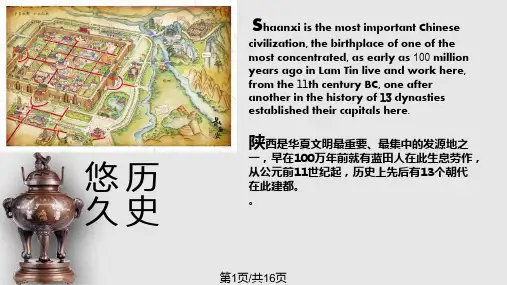
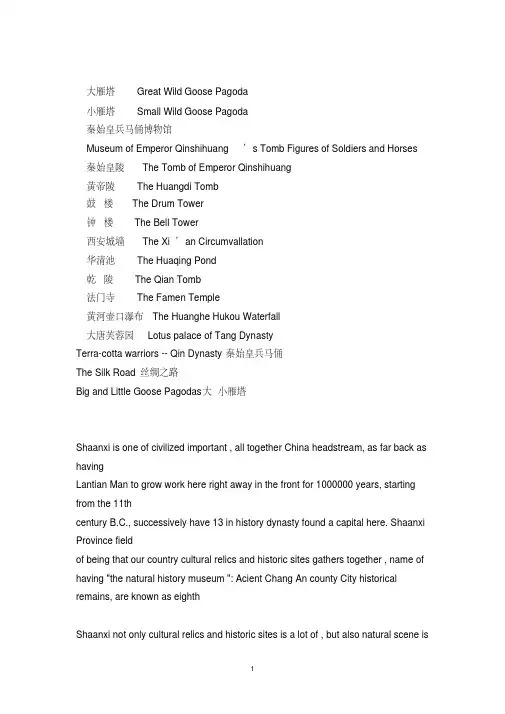
大雁塔Great Wild Goose Pagoda小雁塔Small Wild Goose Pagoda秦始皇兵马俑博物馆Museum of Emperor Qinshihuang’s Tomb Figures of Soldiers and Horses 秦始皇陵The Tomb of Emperor Qinshihuang黄帝陵The Huangdi Tomb鼓楼 The Drum Tower钟楼The Bell Tower西安城墙The Xi’an Circumvallation华清池The Huaqing Pond乾陵 The Qian Tomb法门寺The Famen Temple黄河壶口瀑布The Huanghe Hukou Waterfall大唐芙蓉园Lotus palace of Tang DynastyTerra-cotta warriors -- Qin Dynasty 秦始皇兵马俑The Silk Road 丝绸之路Big and Little Goose Pagodas 大小雁塔Shaanxi is one of civilized important , all together China headstream, as far back as havingLantian Man to grow work here right away in the front for 1000000 years, starting from the 11thcentury B.C., successively have 13 in history dynasty found a capital here. Shaanxi Province fieldof being that our country cultural relics and historic sites gathers together , name of having "the natural history museum ": Acient Chang An county City historical remains, are known as eighthShaanxi not only cultural relics and historic sites is a lot of , but also natural scene is1。
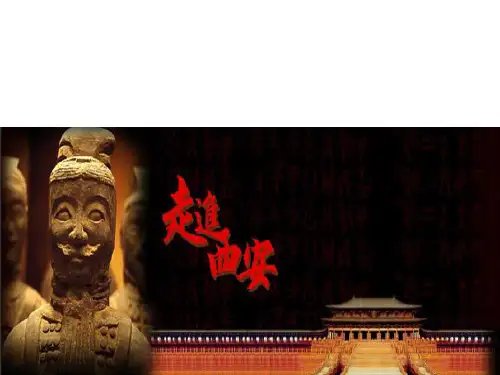

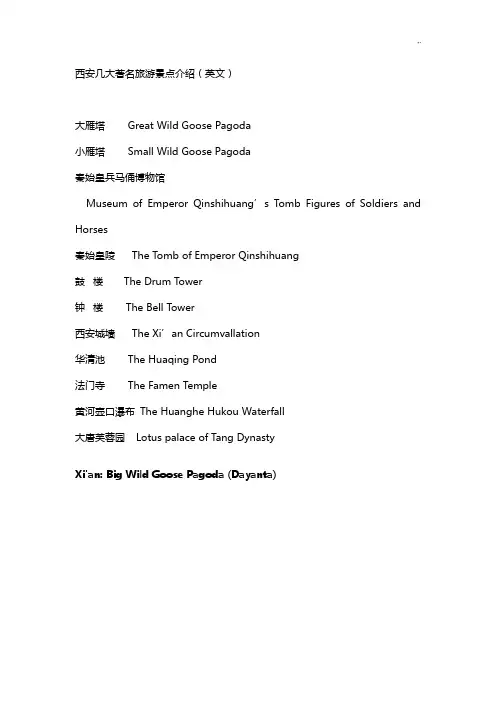
西安几大著名旅游景点介绍(英文)大雁塔Great Wild Goose Pagoda小雁塔Small Wild Goose Pagoda秦始皇兵马俑博物馆Museum of Emperor Qinshihuang’s Tomb Figures of Soldiers and Horses秦始皇陵The T omb of Emperor Qinshihuang鼓楼 The Drum Tower钟楼The Bell T ower西安城墙The Xi’an Circumvallation华清池The Huaqing Pond法门寺The Famen Temple黄河壶口瀑布The Huanghe Hukou Waterfall大唐芙蓉园Lotus palace of Tang DynastyXi'an: Big Wild Goose Pagoda (Dayanta)The Big Wild Goose Pagoda (Dayan Ta),is a Buddhistpagoda built in 652 AD during the Tang Dynasty and originally had five stories.The original construction of rammed earth with a stone exterior facade eventually collapsed five decades later but was rebuilt by Empress Wu Zetian in 704AD who added five more stories. A massive earthquake in 1556 heavily damaged the pagoda and reduced it by three stories to its current height of seven storiesOne of the pagoda's many functions was to hold sutras and figurines of the Buddha that were brought to China from Indiaby Xuanzang, a famous Chinese Buddhist monk, scholar, traveler, andtranslator.Xuanzang is a prominent Buddhist figure mostly known for his seventeen year overland trip to India and back, which is recorded in detail in his autobiography and a biography, and which provided the inspiration for the epic novel “Journey to the West”.The pagoda is built on the premises of the Temple of Great Maternal Grace (Da Ci'en), originally built in 589 AD and then rebuilt 647 AD by the Tang Emperor Gaozong in memory of his mother EmpressWende. Before the gates of the temple stands a statue of Xuanzang.North Square of Big Wild Goose PagodaSurrounding Big Wild Goose Pagoda, the scenery is also quite charming, especially the square north of the Da Ci'en Temple. Covering about 110,000 square meters (131563 square yards) plus 20,000 square meters (23920.6 square yards) of water area, it holds many records: in Asia, it is the biggest Tang-culture square, the biggest fountain and waterscape square, and the largest-scale sculptures area. In the world, it has the most benches, the longest light-belt, and the largest-scale acoustic complex.The entire square is composed of waterscape fountains, a cultural square, gardens and tourist paths. There you can taste real Chinese culture and traditions and fully enjoy the truly attractive views. With reliefs on the theme of the prosperous Tang Dynasty, 200-meter-long (656-foot-long)sculpture groups, 8 groups of sculpted figures, 40 relievos on the land, and 22 styles of musical fountains, it has become a must-see when you visit Big Wild GooseThe Museum of Qin Terra-cotta Warriors and HorsesOne of the most significant archaeological finds in the world, this 16,300-square-meter excavation reveals more than 7,000 life-size terracotta figures of warriors and horses arranged in battle formations. (3 pits)The terracotta warriors and horses, created about 2,200 years ago, were found in 1974 on the east side of the tomb of the First Emperor Qin Shihuang (259 BC - 210 BC) near Xi'an.Emperor Qin Shihuang had Ying as his surname and Zheng as his given name. In 221 B.C., when he unified the whole country, named himself Shihuang Di and carried on the hereditary system.To protect against harassment by the Hun aristocrats. Emperor Qin Shihuang ordered the Great Wall be built.The Bell Tower (Zhonglou)Centrally located on the "Four Main Roads" junction is the Bell Tower, of Xi'an. The original City Bell Tower was constructed in 1582 and situated in the west, but on its reconstruction in 1739, the tower was relocated to its present site. A Ming dynasty bell weighing approximately 14.76 tons hangs in the tower, but no longer chimes to inform residents of the time of day. Visitors have the chance to inspect up-close a number of smaller bells.Although the site itself is more of a landmark than an attraction, it is frequently enlivened with local performances. Visitors interested in local music should visit the site in the morning and early afternoon.Originally, the tower had a number of entrances, but today, it only has one accessible entrance located on Bei Dajie close to the Admission Ticket Office.Xi'an: Drum Tower (Gulou)The Drum Tower was built in 1380 during the early Ming Dynasty, and got its name from the hugedrum located within the building. In contrast to the Bell Tower ,where bell was stricken at dawn, drum was beat at sunset to indicate the end ofthe day.There are twenty-four drums in the northand south sides of the Drum Tower . These drums standfor the Twenty-four Solar Terms, a form of weather calendar created by theChinese in order to guide the agricultural production.The Xi’an CircumvallationThe Xi’an Circumvallation site is located at the center of xi’an city with the form of a rectangular. The circumvallation, with its wall height of 12 meters, bottom width of 18 meters and top width of 15 meters, consists of 4 city gates: changle gate to the east, anding gate to the west, yongling gate to the south and anyuan gate to the north. Its east wall has the length of 2590 meters, west wall of 2631.2 meters, south wall of 3441.6 meters and north wall of 3241 meters. It was constructed on the basis of the tang imperial city and under the strategic consideration of defense. The thickness of the wall is larger than its height and is very solid that cars can run on it. The existing circumvallation was built during 1373-1378 with the history of more than 600 years. It is one of the most famous wall construction in China’s history after the middle ages as well as the most preserved ancient one in China.Small Wild Goose PagodaThe Small Wild Goose Pagoda, sometimes Little Wild Goose Pagoda(Chinese: 小雁塔; pinyin: Xiǎoyàn Tǎ), is one of two significant pagodas in the city of Xi'an, China, the site of the old Han and Tang capital Chang'an. The other notable pagoda is the Giant Wild Goose Pagoda, originally built in 652 and restored in 704. The Small Wild Goose Pagoda was built between 707–709, during the Tang Dynasty under Emperor Zhongzong of Tang (r 705–710). The pagoda stood 45 m (147 ft) until the 1556 Shaanxi earthquake. The earthquake shook the pagoda and damaged it so that it now stands at a height of 43 m (141 ft) with fifteen levels of tiers.[1] The pagoda has a brick frame built around a hollow interior, and its square base and shape reflect the building style of other pagodas from the era.[1]During the Tang Dynasty, the Small Wild Goose Pagoda stood across a street from its mother temple, the Dajianfu Temple. Pilgrims brought sacred Buddhist writings to the temple and pagoda from India, as the temple was one of the main centers in Chang'an for translating Buddhist texts.[1] The temple was older than the pagoda, since it was founded in 684, exactly 100 days after the death of Emperor Gaozong of Tang (r. 649–683).[1] Emperor Zhongzong had donated his residence to the building of a new temple here, maintaining the temple for 200 monks in honor of his deceased father Gaozong.[1] The temple was originally called the Daxianfusi or Great Monastery of Offered Blessings by Zhongzong, until it was renamed Dajianfusi by Empress Wu Zetian in 690.Huaqing Hot SpringsHuaqing Hot Springs, also known as Huaqing Palace, is a well-known historic site and an AAAAA tourist attraction of China. It gets its fame for being the place where the romantic story of Emperor Tangxuanzong of Tang Dynasty (618-907) and his beloved Yang Guifei (or Concubine Yang) took place.As a matter of fact, the site had been as an imperial palace for emperors' short stays away from the capital for more than 3000 years. Emperors of Zhou, Qin, Han, Sui and Tang dynasties spent the winter at this place every year. Emperor Zhouyouwang of Western Zhou Dynasty(1046BC-771BC) is said to be the first emperor who ordered to build a palace at the site. In the following dynasties, the palace was repaired and expanded for several times, given the name of "Hot Spring Palace" and finally denominated "Huaqqing Palace" by Emperor Tangxuanzong. The palace was constructed above hot springs, hence the site is also called "Huaqing Hot Springs".The Famen TempleFamen Temple, renowned for storing the veritable Finger Bone of the Sakyamuni Buddha, is located in Fufeng County of Shaanxi Province. Famen Temple was established in the Eastern Han Dynasty (25--220) for spreading Buddhism. The most representative structures in the temple are the Famen Temple Pagoda and Famen Temple Museum.Many royal treasures and jewelry were found here. But why? Famen Temple was the royal temple during the Sui Dynasty (581-618) and Tang Dynasty. Emperors in Sui and Tang believed that enshrining and worshiping the bone of Sakyamuni would bring richness and peace to the land and its people. So an offering of treasure to the finger bone was made, which was housed in the Underground Palace.Hukou WaterfallThe Hukou waterfall on the Huanghe River west of Jixian County, Shanxi, is formed when the river flows to the Hukou Mountains on the Shanxi-Shaanxi border and its 250-meter-wide bed, sandwiched between the canyons on its banks, abruptly narrows into a trough 50 meters wide and 30 meters deep and falls down into a big stone-strewn pool. The section of the river here is like the mouth of a water-flash. Hence the name of the waterfall, which means “Flask Mouth waterfall”. The waterfall has a descent of 15-20 meters in the low-water season, but it is scarcely noticeable as a waterfall in the high –water season when the waters burst into rapid torrents. The section is rich in hydroelectric power potentialXi'an: Shanxi History MuseumOne thing surprising at the Shaanxi Provincial History Museum was the fact that it is possible, even expected, to bargain for the items sold at the gift shops. One would assume that a museum would have fixed prices. It turns out that ithe prices provide are only the starting price. You should bargain for everything you buy at the gift shop. You can expect to save at least 50%, possibly more.Lotus palace of Tang Dynasty (Tang Paradise)Tang Paradise lies in the Qujiang New District, Xi’An City, Shannxi Province, with 66.7 hectares building areas and 20 hectares of lake areas inside. The garden is the biggest culture theme part in Northwest China, with 1.3 billion RMB investments. The Tang Paradise, which was rebuilt at the north of archaeological site of Lotus Palace of Tang Dynasty, is thefirst large scale royal garden culture theme garden which fully exhibits the living styles and features of Glorious age of Tang Dynasty.In this project, we created a unique night view of “Splendid and magnificent, Glorious age of Tang Dynasty”, by fully controlling the combination of “Lighting”and “Shadow”。
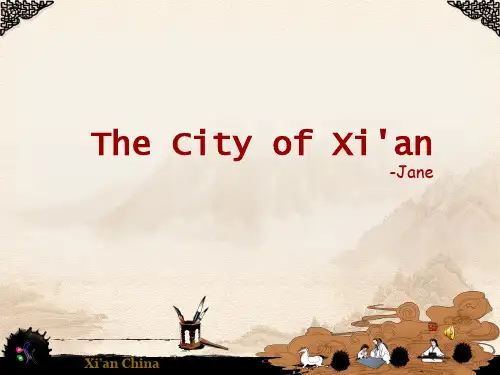
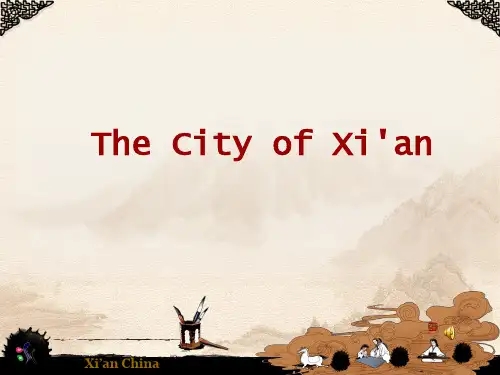
西安旅游景点英文介绍[精彩]大雁塔 Great Wild Goose Pagoda小雁塔 Small Wild Goose Pagoda秦始皇兵马俑博物馆Museum of Emperor Qinshihuang’s Tomb Figures of Soldiers and Horses 秦始皇陵 The Tomb of Emperor Qinshihuang黄帝陵 The Huangdi Tomb鼓楼 The Drum Tower钟楼 The Bell Tower西安城墙The Xi’an Circumvallation华清池 The Huaqing Pond乾陵 The Qian Tomb法门寺 The Famen Temple黄河壶口瀑布 The Huanghe Hukou Waterfall大唐芙蓉园 Lotus palace of Tang DynastyTerra-cotta warriors -- Qin Dynasty 秦始皇兵马俑The Silk Road 丝绸之路Big and Little Goose Pagodas 大小雁塔Shaanxi is one of civilized important , all together China headstream, as far back as havingLantian Man to grow work here right away in the front for 1000000 years, starting from the 11thcentury B.C., successively have 13 in history dynasty found acapital here. Shaanxi Province fieldof being that our country cultural relics and historic sites gathers together , name of having "the natural history museum ": Acient Chang An county City historical remains, are known as eighthShaanxi not only cultural relics and historic sites is a lot of ,but also natural scene isbeautiful: Have precipitous West Hua Mountain and Lin Tong Mt. black horse intelligent and elegant;Huanghe River kettle mouth waterfall having rapids to surge; Still have the organism's habitstourist area giving first place to protecting a giant panda waiting for a rare animal. Not onlynorthern Shaanxi highland be Chinese revolution base area , but also be Shaanxi folk custom localmanners and feelings headstream: Shaanxi opera loud and sonorous , vehement gong and drum ,consummate paper-cut and extremely rich life breath peasant painting etc. , the sight havingattracted more and more many attention's all with it's culture thick and heavy bottom rhyme anddistinctive loess amorous feeling.largest in the world miracle Qin Shi Huang's Buried SculptureLegion , grand grand sight 72emperors mausoleum big or small, ... Distant vast China civilization makes everyone first thepeople who arrives at Shaanxi not excavate heart profundity meditating on the past conscientiouslyXi'an, the capital city of Shaanxi Province, is located in thecentral area of northwest China. It sits on an ancient site and there are layers of cities of different names beneath and around the city. The land is fertile, renewed yearly by the silt from the Yellow River. Since the age of the nomads, people have settled in this rich land to take advantage of the relatively flat landscape, plentiful water, and ease of travel.As one of the ancient capitals of China, it served 12 imperial dynasties for over a thousand years. Today, Xi'an is a treasure house of historical relics and cultural heritage.Xian was called Chang'an in the Han Dynasty, which literally means a place of permanent peace. The city was renamed Xi'an in 1369. From the 11 century B.C. onwards, Xi'an was the capital city of 11 successive dynasties, including the Western Zhou, the Qin, the Han, the Sui and the Tang dynasties; in addition Xi'an had also served as the capital of two peasant regimes, under the rule of Huang Chao and Li Zicheng. The city's capital status lasted for 1,608 years.Indeed, Xi'an has made an unparalleled contribution to the history and culture of China. For more than a millennium, it was the stage on which the histories of more than a dozen Chinese dynasties unfolded.Every move and every action originating from Xi'an had a far-reaching influence on the course of China's social development.It is where, three thousand years ago, the aristocrats of the Zhou dynasty instituted rites and composed music, while offering libations to gods and ancestors and feasting themselves out of bronze utensils. It is where, two thousand years ago, the Qin army eliminated six rival states and initiated the first centralized autocracy, which started off a 20 century-long imperial history in China and exerted a far-reaching influence on subsequent dynasties.Xi'an was the starting point of the famous Silk Road when the pathto wealth emerged during the Han dynasty; and reached its historical apex during the flourishing and prosperous Tang Dynasty 1300 years ago. Many historians believe that the Chang'an of the Tang Dynasty was one of the largest cities in the world; and for thousands of international traders and merchants, Chang'an was a promising land full of fortune.The English word "China" is a transliteration of the Chinese ideogram meaning "Qin". Those who live in and around Xi'an are direct descendents of the Qin people. Emperors chose Xi'an as their capital partly because of its fertile land and sufficient water supply andpartly because it was militarily formidable, because of the mountains that skirted it. It is precisely because of its somewhat isolated location that Xi'an was able to preserve so much of its history and culture to this day.The local dialect of Xi'an and the Guanzhong Plain is reflective of the rhythm and timbre of archaic Chinese. Weddings, funerals, celebrations, diet, and social etiquette are all evocative of the social mores and traditions of the dynasties of the Zhou, Qin, Han and Tang.So it's no wonder that some say Xi'an is the historical center of China today. An ancient philosopher once mused that all those seeking the truth should go to China; and a contemporary philosopher consolidated it with that no visit to China is complete without a journey to Xi'an.Today, the rich historical and cultural heritage of Xi'an is visible through a wealth of cultural relics, museums, and historical sites including the world-famous terracotta warriors of Emperor Qin Shi Huang. The flat plane on the city's outskirts is strewn with the tomb mounds of emperors, empresses, aristocrats, ranking officials and scholars from ancient times. The remains of past civilizations are evidence of every major epoch in China's half a million year history. The history apparent in Xian is so ancient and continuous that the city has no parallel anywhere as a cultural site.In Xi'an you will find yourself in a world of amazing artifacts. You can visit the sites once inhabited by China's primitive people; admire the bronze wares manufactured in the Bronze Age; wander through the city ruins of the Qin, Han, Sui and Tang Dynasties; imagine the hustle and bustle of the old Oriental metropolis; you can go to explore theimperial tombs of the Qin, Han and Tang Dynasties, testimony to thepervasive power of the feudal ruling class; you can also wander through temples and pagoda courtyards, tracing vestiges of the Silk Road; and study stone inscriptions to appreciate Chinese calligraphy. Not least, the site of the spectacular army of terracotta warriors and horses from the tomb of China's First Emperor, Qin Shihuang, is amust-see in your trip in Xi'an.0. 西安地理位置1. Xi'an lies on the Guanzhong Plain in central China, on a flood plain createdby the eight surrounding rivers and streams. The Wei River provides potable waterto the city.2. The city borders the northern foot of the Qinling Mountains to the south, andthe banks of the Wei River to the north. Hua Shan, one of the five sacred Taoistmountains, is located 100 km away to the east of the city.Guanzhong Plain, which is located behind Xiao Pass and Hangu Pass, connects Long Plain and Shu Plain. Land of thousands miles and rich in harvest can be found here, as if this place is belongs to the nation of the heaven.关中左崤函, 右陇蜀, 沃野千里, 此所谓金城千里, 天府之国也《史记?留侯世家》)1.秦始皇兵马俑The Terracotta Army or the "Terra Cotta Warriors and Horses", is a collection of terracotta sculptures depicting the armies of Qin Shi Huang, the first Emperor of China. It is a form of funerary art buried with the emperor in 210–209 BC and whose purpose was to protect the emperor in his afterlife, and to make sure that he had people torule over.The figures, dating from 3rd century BC, were discovered in 1974 by some local farmers in Lintong District, Xi'an, Shaanxi province.The figures vary in height according to their roles, with thetallest being the generals. The figures include warriors, chariots and horses. Current estimates are that in the three pits containing the Terracotta Army there were over 8,000 soldiers, 130 chariots with 520 horses and 150 cavalry horses, the majority of which are still buried in the pits near by Qin Shi Huang's mausoleum. Other terracotta non-military figures were also found in other pits and they include officials, acrobats, strongmen and musicians.2.大雁塔As the symbol of the old-line Xian, Big Wild Goose Pagoda is a well-preserved ancient building and a holy place for Buddhists. It is located in the southern suburb of Xian City, about 4 kilometers from the downtown of the city. Originally built in 652 during the reign of Emperor Gaozong of the Tang Dynasty , it functioned to collect Buddhist materials that were taken from India by the hierarch Xuanzang.3.饺子宴When traveling in Xian, one pleasure you should not miss is the Dumpling Banquet. Dumpling or Jiaozi in Chinese is a traditional and still popular food in China. A banquet will feature nearly 20 varieties that are stuffed and cooked using a delicious assortment of vegetables, meats and seafood. These dumplings feature harmony between a variety of tastes and textures for an enjoyable eating experience.肉夹馍、臊子面等美食4.华清宫In Tang dynasty , emperor Xuan Zong and his favorite concubine lady Yang used to make their home here since it was cold in the capital Chang’an .。
西安旅游景点英文介绍 (带图片)大雁塔 Great Wild Goose Pagoda小雁塔 Small Wild Goose Pagoda鼓楼 The Drum Tower钟楼 The Bell Tower西安城墙 The Xi’an Circumvallation大唐芙蓉园 Lotus palace of Tang Dynasty秦始皇兵马俑博物馆 Museum of Emperor Qinshihuang ’s Tomb Figures of Soldiers and Horses 秦始皇陵 The Tomb of Emperor Qinshihuang黄帝陵 The Huangdi Tomb华清池 The Huaqing Pond乾陵 The Qian Tomb法门寺 The Famen Temple黄河壶口瀑布 The Huanghe Hukou Waterfall1. Xi'an city wall 西安城墙景区地址:西安市南门里Xi'an city wall is located in the center of the city---- Total perimeter 11.9 kilometers.The existing walls were built during the seven years to eleven years (1374 hongwu--- 1378 hongwu) , it’s the oldest shape in the world, the most spectacular and best-preserved ancient buildings.Ticket: 40 yuanCard discount: Open-times free admission tours, excluding Mid-Autumn Festival, Oct.1st holiday, Chinese New Year Lantern Festival Phone :029 -84057153, 87235239By car: take the city bus to arrive at the South Gate , North Gate, West Gate, or East Gatebus stop大雁塔 Great Wild Goose Pagoda大唐芙蓉园 Lotus palace of Tang DynastySituated in Huayin City, 120 kilometers (about 75 miles) east from Xi'an City of Shaanxi Province, Mt. Huashan is known as 'The Number One.Precipitous Mountain under Heaven'.It is one of the five sacred mountains in China. The other four mountains are Mt. Taishan in Shandong, Mt. Hengshan in Hunan, Mt. Hengshan in Shanxi, and Mt. Songshan in Henan. In ancient times, Mt. Huashan was called Mt. Taihuashan. From a distance the five peaks seem to form the shape of a 'flower' (hua in Chinese), hence the name 'Huashan'. It is famous for its natural vistas of steep and narrow paths, precipitous crags, and a high mountain range. It is home to several influential Taoist temples where emperors of past dynasties made pilgrimages, making Mt. Huashan the holy land of Taoism.。
大雁塔Great Wild Goose Pagoda小雁塔Small Wild Goose Pagoda秦始皇兵马俑博物馆Museum of Emperor Qinshihuang’s Tomb Figures of Soldiers and Horses秦始皇陵The Tomb of Emperor Qinshihuang黄帝陵The Huangdi Tomb鼓楼 The Drum Tower钟楼The Bell Tower西安城墙The Xi’an Circumvallation华清池The Huaqing Pond乾陵 The Qian Tomb法门寺The Famen Temple黄河壶口瀑布The Huanghe Hukou Waterfall大唐芙蓉园Lotus palace of Tang DynastyTerra-cotta warriors -- Qin Dynasty 秦始皇兵马俑The Silk Road 丝绸之路Big and Little Goose Pagodas 大小雁塔Shaanxi is one of civilized important , all together China headstream, as far back as havingLantian Man to grow work here right away in the front for 1000000 years, starting from the 11thcentury B.C., successively have 13 in history dynasty found a capital here. Shaanxi Province fieldof being that our country cultural relics and historic sites gathers together , name of having "the natural history museum ": Acient Chang An county City historical remains, are known as eighthShaanxi not only cultural relics and historic sites is a lot of , but also natural scene isbeautiful: Have precipitous West Hua Mountain and Lin Tong Mt. black horse intelligent and elegant;Huanghe River kettle mouth waterfall having rapids to surge; Still have the organism's habitstourist area giving first place to protecting a giant panda waiting for a rare animal. Not onlynorthern Shaanxi highland be Chinese revolution base area , but also be Shaanxi folk custom localmanners and feelings headstream: Shaanxi opera loud and sonorous , vehement gong and drum ,consummate paper-cut and extremely rich life breath peasant painting etc. , the sight havingattracted more and more many attention's all with it's culture thick and heavy bottom rhyme anddistinctive loess amorous feeling.largest in the world miracle Qin Shi Huang's Buried Sculpture Legion , grand grand sight 72emperors mausoleum big or small, ... Distant vast China civilization makes everyone first thepeople who arrives at Shaanxi not excavate heart profundity meditating on the past conscientiouslyXi'an, the capital city of Shaanxi Province, is located in the central area of northwest China. It sits on an ancient site and there are layers of cities of different names beneath and around the city. The land is fertile, renewed yearly by the silt from the Yellow River. Since the age of the nomads, people have settled in this rich land to take advantage of the relatively flat landscape, plentiful water, and ease of travel.As one of the ancient capitals of China, it served 12 imperial dynasties for over a thousand years. Today, Xi'an is a treasure house of historical relics and cultural heritage.Xian was called Chang'an in the Han Dynasty, which literally means a place of permanent peace. The city was renamed Xi'an in 1369. From the 11 century B.C. onwards, Xi'an was the capital city of 11 successive dynasties, including the Western Zhou, the Qin, the Han, the Sui and the Tang dynasties; in addition Xi'an had also served as the capital of two peasant regimes, under the rule of Huang Chao and Li Zicheng. The city's capital status lasted for 1,608 years.Indeed, Xi'an has made an unparalleled contribution to the history and culture of China. For more than a millennium, it was the stage on which the histories of more than a dozen Chinese dynasties unfolded. Every move and every action originating from Xi'an had a far-reaching influence on the course of China's social development.It is where, three thousand years ago, the aristocrats of the Zhou dynasty instituted rites and composed music, while offering libations to gods and ancestors and feasting themselves out of bronze utensils. It is where, two thousand years ago, the Qin army eliminated six rival states and initiated the first centralized autocracy, which started off a 20 century-long imperial history in China and exerted a far-reaching influence on subsequent dynasties.Xi'an was the starting point of the famous Silk Road when the path to wealth emerged during the Han dynasty; and reached its historical apex during the flourishing and prosperous Tang Dynasty 1300 years ago. Many historians believe that the Chang'an of the Tang Dynasty was one of the largest cities in the world; and for thousands of international traders and merchants, Chang'an was a promising land full of fortune.The English word "China" is a transliteration of the Chinese ideogram meaning "Qin".Those who live in and around Xi'an are direct descendents of the Qin people. Emperors chose Xi'an as their capital partly because of its fertile land and sufficient water supply and partly because it was militarily formidable, because of the mountains that skirted it. It is precisely because of its somewhat isolated location that Xi'an was able to preserve so much of its history and culture to this day.The local dialect of Xi'an and the Guanzhong Plain is reflective of the rhythm and timbre of archaic Chinese. Weddings, funerals, celebrations, diet, and social etiquette are all evocative of the social mores and traditions of the dynasties of the Zhou, Qin, Han and Tang.So it's no wonder that some say Xi'an is the historical center of China today. An ancient philosopher once mused that all those seeking the truth should go to China; and a contemporary philosopher consolidated it with that no visit to China is complete without a journey to Xi'an.Today, the rich historical and cultural heritage of Xi'an is visible through a wealth of cultural relics, museums, and historical sites including the world-famous terracotta warriors of Emperor Qin Shi Huang. The flat plane on the city's outskirts is strewn with the tomb mounds of emperors, empresses, aristocrats, ranking officials and scholars from ancient times. The remains of past civilizations are evidence of every major epoch in China's half a million year history. The history apparent in Xian is so ancient and continuous that the city has no parallel anywhere as a cultural site.In Xi'an you will find yourself in a world of amazing artifacts. You can visit the sites once inhabited by China's primitive people; admire the bronze wares manufactured in the Bronze Age; wander through the city ruins of the Qin, Han, Sui and Tang Dynasties; imagine the hustle and bustle of the old Oriental metropolis; you can go to explore the imperial tombs of the Qin, Han and Tang Dynasties, testimony to the pervasive power of the feudal ruling class; you can also wander through temples and pagoda courtyards, tracing vestiges of the Silk Road; and study stone inscriptions to appreciate Chinese calligraphy. Not least, the site of the spectacular army of terracotta warriors and horses from the tomb of China's First Emperor, Qin Shihuang, is amust-see in your trip in Xi'an.。
西安旅游景点英文介绍(带图片)
大雁塔Great Wild Goose Pagoda
小雁塔Small Wild Goose Pagoda
鼓楼The Drum Tower
钟楼The Bell Tower
西安城墙The Xi’an Circumvallation
大唐芙蓉园Lotus palace of Tang Dynasty
秦始皇兵马俑博物馆Museum of Emperor Qinshihuang ’s Tomb Figures of Soldiers and Horses 秦始皇陵The Tomb of Emperor Qinshihuang
黄帝陵The Huangdi Tomb
华清池The Huaqing Pond
乾陵The Qian Tomb
法门寺The Famen Temple
黄河壶口瀑布The Huanghe Hukou Waterfall
1. Xi'an city wall 西安城墙景区
地址:西安市南门里Xi'an city wall is located in the center of the city----Total perimeter 11.9 kilometers.
The existing walls were built during the seven years to eleven years (1374 hongwu--- 1378 hongwu) , it’s the oldest shape in the world, the most spectacular and best-preserved ancient buildings.
Ticket: 40 yuan
Card discount: Open-times free admission tours, excluding Mid-Autumn Festival, Oct.1st holiday, Chinese New Year Lantern Festival Phone :029 -84057153, 87235239
By car: take the city bus to arrive at the South Gate , North Gate, West Gate, or East Gate
bus stop
大雁塔Great Wild Goose Pagoda
大唐芙蓉园Lotus palace of Tang Dynasty
Situated in Huayin City, 120 kilometers (about 75 miles) east from Xi'an City of Shaanxi Province, Mt. Huashan is known as 'The Number One.Precipitous Mountain under Heaven'.It is one of the five sacred mountains in China. The other four mountains are Mt. Taishan in Shandong, Mt. Hengshan in Hunan, Mt. Hengshan in Shanxi, and Mt. Songshan in Henan. In ancient times, Mt. Huashan was called Mt. Taihuashan. From a distance the five peaks seem to form the shape of a 'flower' (hua in Chinese), hence the name 'Huashan'. It is famous for its natural vistas of steep and narrow paths, precipitous crags, and a high mountain range. It is home to several influential Taoist temples where emperors of past dynasties made pilgrimages, making Mt. Huashan the holy land of Taoism.。